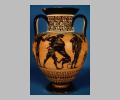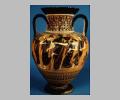| Collection: | Museum of Fine Arts, Boston |
| Summary: | Side A: Herakles fighting the Nemean lion |
| Ware: | Attic Black Figure |
| Painter: | Kinship with the Antimenes Painter |
| Date: | ca. 530 BC - ca. 520 BC |
| Dimensions: | H 0.376 m; D 0.258 m |
| Primary Citation: | |
| Shape: | Neck amphora |
| Beazley Number: | 340502 |
| Period: | Archaic |
Condition:
Chips on the rim of the vase. The glaze is peeled in places (the edge of the foot, the rays).
Decoration Description:
Side A: Herakles is shown wrestling the Nemean Lion, between Iolaos and Hermes. Iolaos is on the left, standing in profile to the right. He wears a cuirass over a short chiton, and a scabbard suspended from a baldric at his side. His left arm is raised as if cheering Herakles on. Herakles and the lion are facing each other, the lion standing on its hind legs with its forelegs wrapped around Herakles. It is clawing Herakles' knee with its left hind paw. Herakles has it by the neck in a wrestling hold. He wears a short chiton and a scabbard suspended from a baldric. The lion's mane and stripes on his rib cage are painted red. Hermes, on the right, also wears a short chiton, but with a red chlamys over it. He wears boots, a petasos, and holds the kerykeion with his right hand at chest level. He stands to the right, but turns to face Herakles. Herakles and Hermes have red beards; Iolaos is beardless. The folds on the chitons of Herakles and Iolaos are painted red; the dot rosettes on all three chitons are painted white.
Side B: Dionysos stands in the middle of the composition, in profile to the right. He wears an ivy wreath (every other leaf painted red), long chiton and himation with red-painted folds. He holds a large kantharos in his left hand, and an ivy vine in his right. About him dance four maenads, wearing chitons decorated with red and white paint and short mantles. The maenads on the far left and far right have ivy wreaths in their hair, which falls over their shoulders. The maenad immediately to the left of Dionysos wears her hair in a sakkos, while the one on his right wears hers tied up under a fillet. All maenads wear necklaces, indicated by an incised wavy line.
On the neck of the vase is a palmette-lotus chain, and on the shoulder a tongue pattern (alternate tongues painted red) framed by horizontal lines. Above the foot are rays, surmounted by a chain of upright lotus buds and a meander. The handle sides are decorated with four palmettes, three lotuses, and a central dot.
Collection History:
Gift of Thomas G. Appleton, 1876.
Sources Used:
Other Bibliography:
Greek gods and heroes as represented in the classical collections of the Museum: a handbook for high school students (Cambridge, Mass. 1927) 57, fig. 49The Ceramic Art (New York, 1878), 229Back Bay Boston: The City as a Work of Art (Boston 1969) 92

